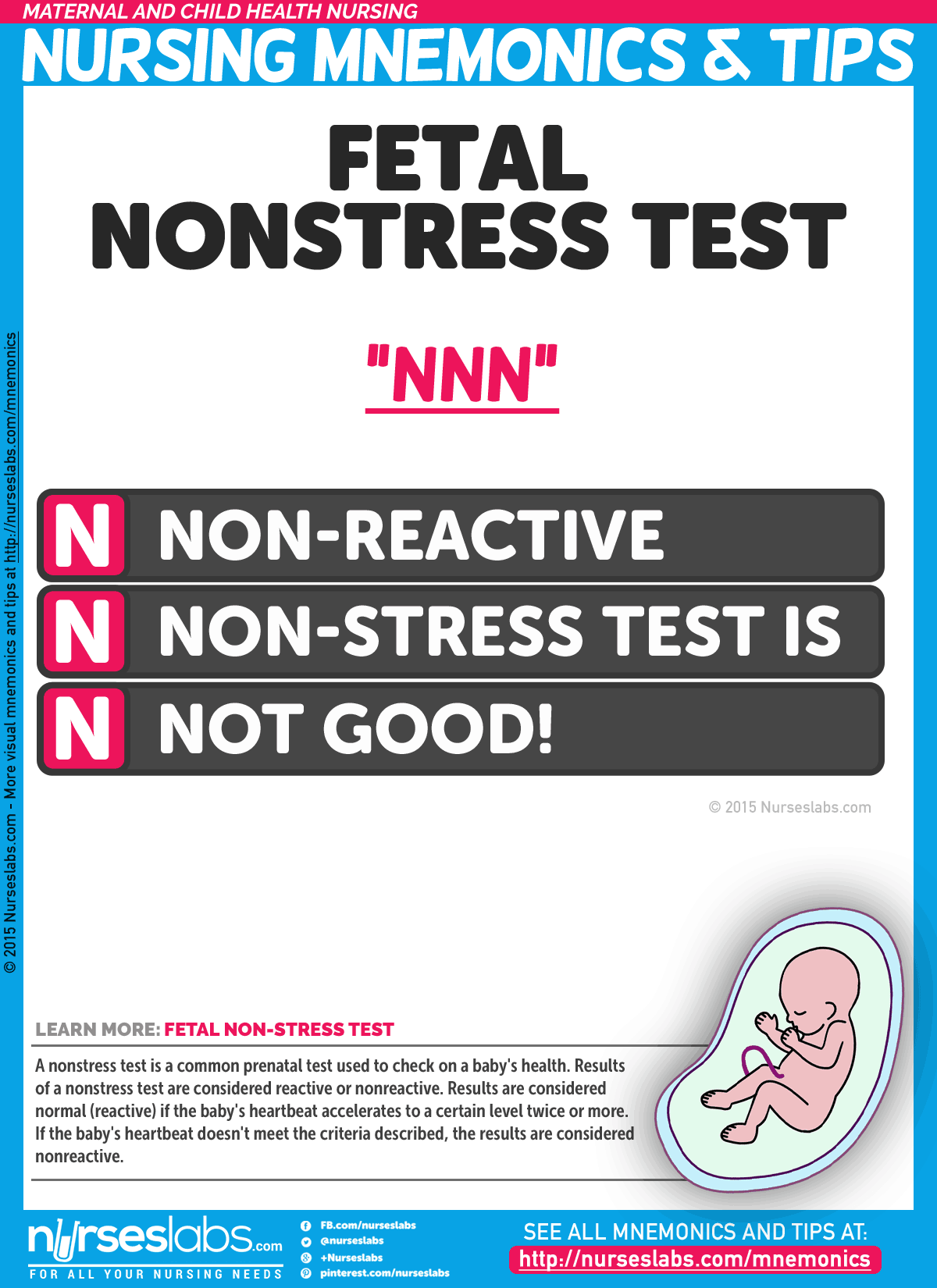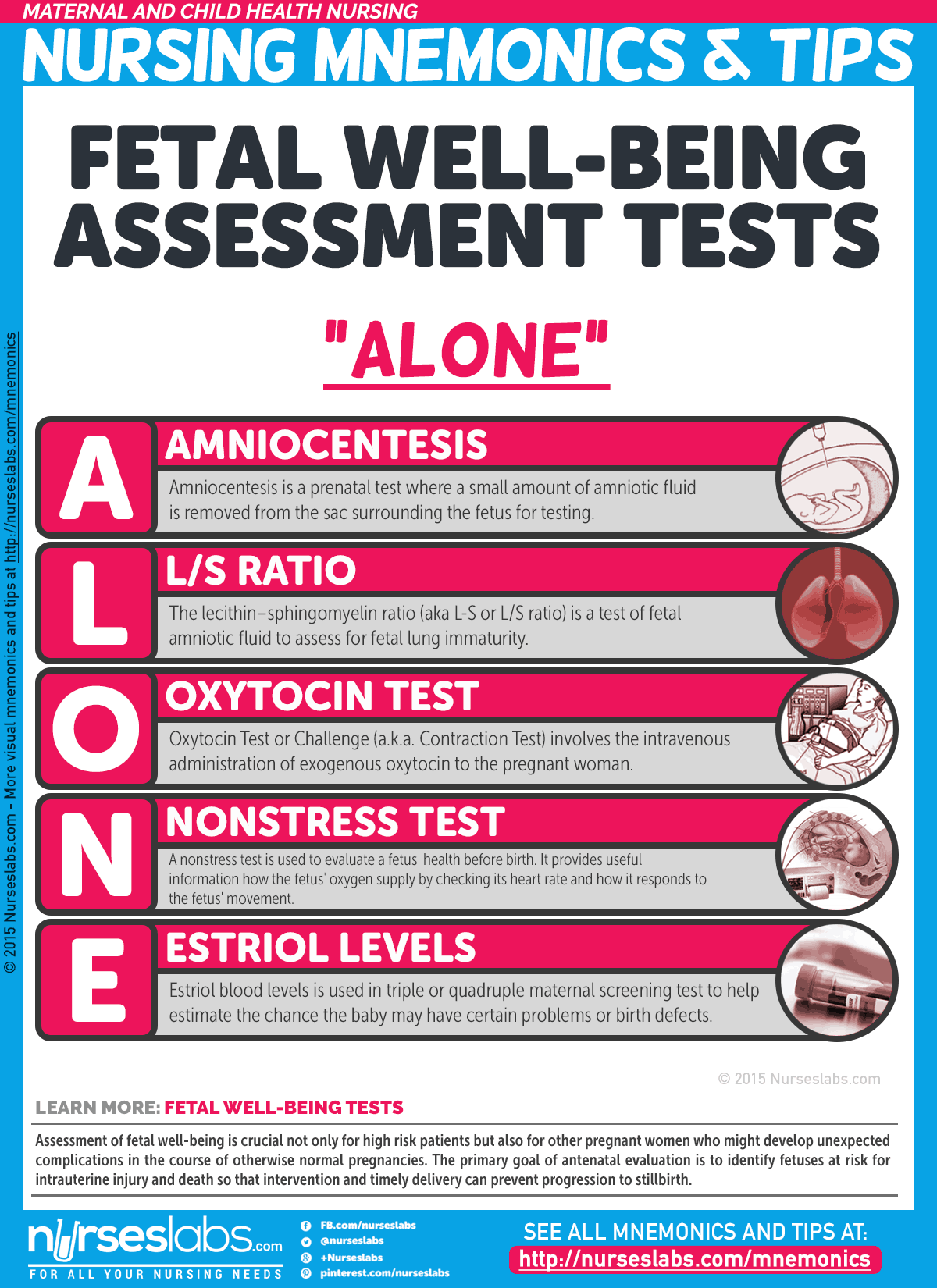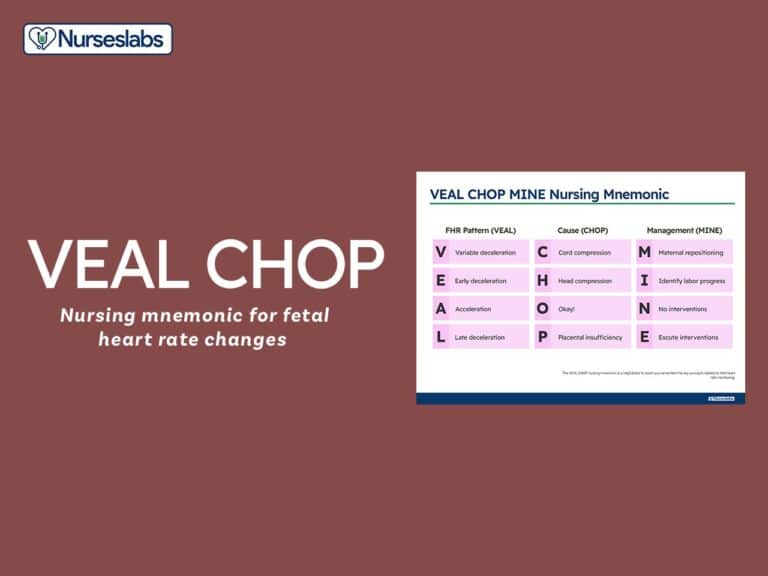The VEAL CHOP nursing mnemonic and BUBBLE HE postpartum assessment are some of our many tips to help you understand maternal and child health nursing. Below are some visual nursing mnemonics and tips about Maternal and Child Health Nursing (includes obstetric and gynecological disorders, and maternity nursing) that can help you understand the core concepts more easily!
Maternal and child (or newborn) health nursing encompasses a wide scope of practice. It is not only associated with childbearing but throughout time, it has evolved in caring for the woman before, during, and after her pregnancy including the care of her newborn. With their knowledge, skills, and passion, nurses help meet the care needs of their client throughout the lifespan, whether the patient is pregnant, a fetus, or a partner, or a woman with a health-related problems. The overall goal of maternal and newborn nursing is to promote and maintain optimal health of the woman and her family and in studying this weave of concepts in nursing, students nurses may find themselves lost in vastness of maternal and child health nursing.
1. VEAL CHOP Nursing Fetal Accelerations and Decelerations
The trick to the VEAL CHOP nursing mnemonic is to write it in a way that each letter is associated with the one beside it. The VEAL CHOP nursing acronym is a trick to remember fetal heart rate patterns. Variable decelerations are associated with cord compression (V and C). Early decelerations are associated with head compression. This is generally a benign event (E and H). Accelerations are associated with oxygenation, which explains why they’re generally a good prognostic factor (A and O). Late decelerations are associated with placental insufficiency (L and P).
This mnemonic is explained comprehensively here: VEAL CHOP Nursing Mnemonic
2. BUBBLE-HE Postpartum Assessment
The nursing mnemonic BUBBLE-HE is used to remember the components of the postpartum maternal assessment. Nurses need to be aware of the normal physiologic and psychological changes that take place in women’s bodies and minds in order to provide comprehensive care during this period. The postpartum period covers the time period from birth until approximately six weeks after delivery. So it is important to remember the mnemonic BUBBLE-HE to denote the components of the postpartum maternal nursing assessment.
3. NNN: Fetal Non-Stress Test
A nonstress test is a common prenatal test used to check on a baby’s health. Results of a nonstress test are considered reactive or nonreactive. Results are considered normal (reactive) if the baby’s heartbeat accelerates to a certain level twice or more. If the baby’s heartbeat doesn’t meet the criteria described, the results are considered nonreactive.
4. ALONE: Fetal Wellbeing Assessment Tests
Assessment of fetal well-being is crucial not only for high risk patients but also for other pregnant women who might develop unexpected complications in the course of otherwise normal pregnancies. The primary goal of antenatal evaluation is to identify fetuses at risk for intrauterine injury and death so that intervention and timely delivery can prevent progression to stillbirth.
- Amniocentesis is a prenatal test where a small amount of amniotic fluid is removed from the sac surrounding the fetus for testing. Different tests can be performed on a sample, but it is used mainly to look for certain types of birth defects, such as Down syndrome, a chromosomal abnormality.
- The lecithin–sphingomyelin ratio (aka L-S or L/S ratio) is a test of fetal amniotic fluid to assess for fetal lung immaturity.
- Oxytocin Test or Challenge (a.k.a. Contraction Test) involves the intravenous administration of exogenous oxytocin to the pregnant woman. The target is to achieve around three contractions every ten minutes.
- A nonstress test is used to evaluate a fetus’ health before birth and provides useful information how the fetus’ oxygen supply by checking its heart rate and how it responds to the fetus’ movement.
- Levels of estriol in the blood is used in maternal serum triple or quadruple screening test that is done between 15 and 20 weeks. The levels of the substances measured helps estimate the chance that the baby may have certain problems or birth defects.
5. REEDDA: Episiotomy Healing Evaluation
If the mother had an episiotomy or vaginal tear during delivery, the wound might hurt for a few weeks. Extensive tears might take longer to heal. The patient will have a vaginal discharge (lochia) for a number of weeks after delivery. Expect a bright red, heavy flow of blood for the first few days. The discharge will gradually taper off, becoming watery and changing from pink or brown to yellow or white. So it is always important to check for REEDA.
6. HELLP Syndrome: Severe Pre-Eclampsia
HELLP syndrome nursing mnemonic is a life-threatening pregnancy complication usually considered to be a variant of preeclampsia. Both conditions usually occur during the later stages of pregnancy, or sometimes after childbirth.
7. 9 & 16: Chorionic Villi Sampling & Alpha-fetoprotein
- “Chorionic” has 9 letters and CVS is performed at 9 weeks gestation.
- “Alpha Fetoprotein” has 16 letters and is measured at 16 weeks gestation.
Chorionic villus sampling (CVS) is a first-trimester (10 to 12 weeks) alternative to amniocentesis for prenatal diagnosis of genetic abnormalities. This procedure is accomplished by needle aspiration of a sample of chorionic villi, either by the transcervical or transabdominal route.
Alpha-fetoprotein is a fetal protein produced in the yolk sac during the first 6 weeks of gestation and later by the fetal liver. AFP is found in the amniotic fluid and maternal serum. If the fetus has neural tube defect, AFP levels are elevated.
8. ABCDEF: Prenatal Care Assessment
If you are lost with your assessment, remember the nursing mnemonic “ABCDEF” for the possible areas you can ask. The first prenatal visit is a time to establish rapport and baseline data relevant to the patient’s health. This begins with obtaining a health history, including screening for any presence of teratogens and concerns the woman may be experiencing.
- A: Amniotic fluid leakage
Check whether amniotic fluid is clear, blood-tinged (pink), green, or brown. A woman can tell the difference between urine and amniotic fluid because the fluid keeps leaking and she can’t control its release. - B: Bleeding vaginally
Bleeding during pregnancy can happen any time from conception to the end of pregnancy. Any bleeding or spotting can be a sign of pregnancy where the fertilized egg develops outside the uterus (ectopic). An untreated ectopic pregnancy can be life-threatening for the woman. - C: Contractions
A pregnant mother may experience them from as early as six weeks into pregnancy to the very end, or not at all. These contractions typically feel like a tightening or hardening across the abdomen and should be irregular and totally painless. - D: Dysuria
Pregnant women are also more susceptible to urinary tract infections. Be careful not to confuse increased frequency of urination with a bladder infection (cystitis). If a pregnant woman notices that she is urinating more frequently, that urination is painful (dysuria), or that she has a fever, she may have an infection. - E: Edema
Edema is when excess fluid collects in the tissue. It’s normal to have a certain amount of swelling during pregnancy because of water retention. Edema is most likely to trouble during the third trimester. It may be particularly severe for women with excessive amniotic fluid or those carrying multiples. - F: Fetal movement (quickening)
This can usually be felt between 16 and 23 weeks; movements are intermittent and infrequent.
9. LARA CROFT: Abdominal Pain Causes During Pregnancy
Intermittent abdominal discomfort or pain is a common pregnancy complaint. While itself may present to be harmless, it can also be a sign of a serious problem. There can be many causes for abdominal pain especially during pregnancy, remember the nursing mnemonic “LARA CROFT” to remind you.
- L: Labor
Labor contractions usually cause discomfort or a dull ache in a pregnant woman’s back and lower abdomen, along with pressure in the pelvis. - A: Abruptio Placenta
The premature separation of placenta from the uterus and typically presents with bleeding, uterine contractions, and fetal distress. Puts mother and fetus in serious danger if left untreated. - R: Rupture (e.g., ectopic/uterine rupture)
Ruptured ectopic pregnancy often results in internal bleeding and intense abdominal pain.
Rupture of the uterus results in bleeding, rupture of the amniotic sac; it is a serious emergency. - A: Abortion (Spontaneous)
Spontaneous abortion (a.k.a. miscarriage) is the unintentional expulsion of an embryo or fetus before the 24th week of gestation; manifests with abdominal cramps and vaginal bleeding. - C: Cholestasis
Cholestasis is the impairment of bile flow from the liver that can trigger intense itching and abdominal pain. It poses no risk for the mother but can be dangerous for the developing baby. - R: Rectus sheath hematoma (RSH)
It is a rare hematoma within the rectus sheath that produces a painful, tender swelling that can mimic an intraperitoneal mass with features of an acute abdomen. - O: Ovarian tumor
Ovarian cysts typically occur in the second trimester and typically do not pose risks to the mother or fetus; can naturally resolve themselves before or soon after childbirth. - F: Fibroids
Fibroids are benign tumors that originate in the uterus and are composed of the same smooth muscle fibers as the myometrium; usually poses no problems during pregnancy. - T: Torsion of the uterus
It is the rotation of more than 45 degrees around the long axis of the uterus; manifests with severe abdominal pain, tense uterus, and fetal distress. It may be due to structural abnormalities in the pelvis.
10. ‘PRE’Eclampsia: Preeclampsia Classic Triad
Preeclampsia is a complication characterized by high blood pressure and signs of damage to another organ system (usually the kidneys). The condition usually begins after 20 weeks of pregnancy in a woman whose blood pressure had been normal. Even a slight rise in blood pressure may be a sign of preeclampsia.
- P: Proteinuria
Proteinuria is defined as > 300 mg/24 h. Alternatively, proteinuria is diagnosed based on a protein:creatinine ratio ≥ 0.3 or a dipstick reading of 1+. Absence of proteinuria on less accurate tests (eg, urine dipstick testing, routine urinalysis) does not rule out preeclampsia. - R: Rising blood pressure
High blood pressure may develop slowly, but more commonly it has a sudden onset. Blood pressure that is 140/90 millimeters of mercury (mm Hg) or greater — documented on two occasions, at least four hours apart — is abnormal. - E: Edema
Sudden weight gain and swelling (particularly in the face and hands) often manifests; pitting edema–an unusual swelling, particularly of the hands, feet, or face, notable by leaving an indentation when pressed on.
Know a few witty nursing mnemonics? If you some mnemonics about this topic, please do share them at our comments section below! Else, there are more nursing mnemonics here.



























Leave a Comment